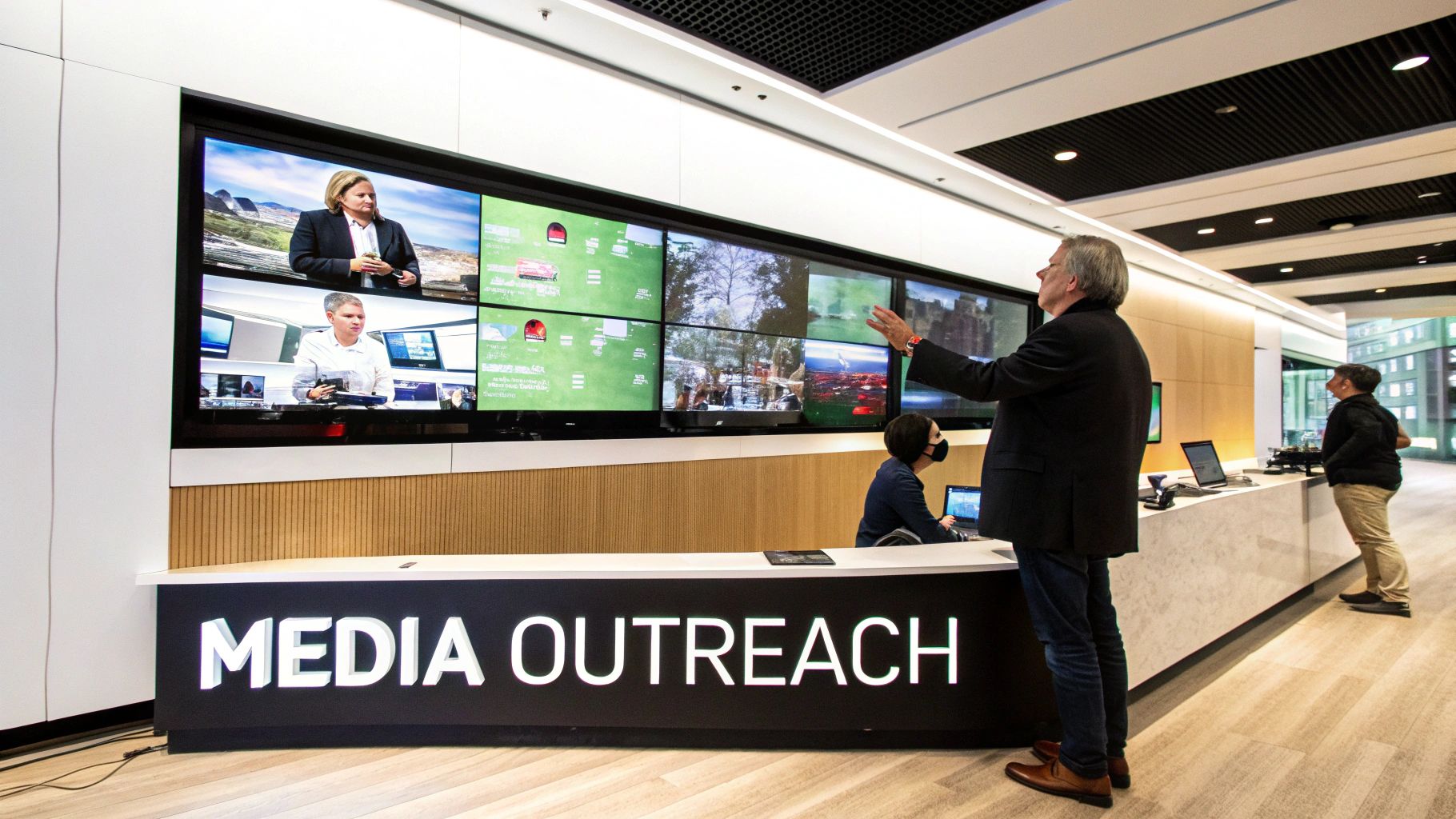
Digital PR Strategy: Amplify Your Brand Impact
The Evolution of Digital PR in the UK Media Landscape

Digital PR has fundamentally changed how UK businesses connect with their audiences. Forget the old days of simply sending press releases and hoping for the best. Today, a successful digital PR strategy is about building genuine relationships and crafting compelling content that resonates with journalists and your target audience alike. This represents a significant shift from transactional publicity to a more relational approach. It's about nurturing connections and building a community around your brand.
From Press Releases to Captivating Content
Traditional PR often relied on press releases sent to media outlets. Digital PR expands this by creating diverse content. Think blog posts, infographics, videos, and even interactive experiences. This rich content allows brands to tell more compelling stories and engage their audience on multiple levels. Imagine a financial services company creating a series of videos explaining complex financial concepts simply and clearly. This builds trust and positions them as an authority in their field.
Integrating Digital PR With Your Core Marketing Strategy
Effective digital PR isn't a standalone tactic. It's a vital piece of a comprehensive marketing strategy. Your digital PR efforts should align with your overall business objectives and integrate seamlessly with other marketing activities. This ensures consistent messaging and creates a cohesive brand experience across all channels. A well-defined strategy also helps track progress and measure the impact of PR on your business goals. Choosing the right content marketing KPIs is crucial for measuring success.
The Rising Power of Digital PR in the UK
Interest in digital PR within the UK is booming. Since 2020, searches related to digital PR have climbed by 49% as of 2024. This highlights the growing recognition of digital PR's importance for brand visibility and a strong online presence. In the UK, Google searches for “digital PR” average around 8,020 per month. This growing interest is further evidenced by the 14,203 posts mentioning "digital PR" on platforms like X (formerly Twitter) and Reddit, reaching a combined audience of 735 million in 2024. Learn more from these insightful digital PR statistics. This underscores the understanding that a powerful online presence is essential for success in today’s competitive market.
Beyond Media Mentions: Building Lasting Brand Authority
While media mentions still hold value, digital PR strives for much more. A robust digital PR strategy focuses on building brand authority, driving targeted website traffic, and ultimately, generating leads and sales. This requires a strategic approach to content creation and distribution. The focus should be on creating engaging content that resonates with your audience and inspires them to take action. These efforts contribute to long-term brand building and sustainable business growth.
Crafting Digital PR Goals That Drive Business Growth
Setting clear, measurable goals is crucial for any successful digital PR strategy. Forget vague ambitions like "getting coverage." Instead, let's explore how to establish objectives that directly impact your business’s bottom line. This means shifting from vanity metrics to those that truly reflect growth. There's often a disconnect between traditional PR metrics like impressions and actual business results. This section bridges that gap, providing frameworks used by successful brands to align their digital PR with meaningful, sustainable growth.
Aligning PR With Business Outcomes
Effective digital PR isn't just about securing media mentions; it's about achieving tangible business results. A FinTech startup, for example, might aim to increase website traffic from qualified leads. Meanwhile, an established financial services firm might focus on strengthening its reputation as a thought leader. This requires defining clear objectives that connect media coverage to desired outcomes. Think increased website traffic, lead generation, and improved conversion rates. Imagine your digital PR strategy as a bridge connecting media attention to tangible business impacts.
Setting SMART Goals for Digital PR
Successful digital PR campaigns leverage the SMART goals framework. This means goals are Specific, Measurable, Achievable, Relevant, and Time-bound. Instead of aiming for "more website traffic," a SMART goal might be "increase website traffic from organic search by 20% in the next quarter." This provides a clear target and timeline for your efforts. Each goal should directly contribute to broader business objectives, ensuring every PR activity adds value.
Establishing Realistic Benchmarks and Measuring Success
Setting benchmarks is essential for tracking progress and demonstrating the value of your digital PR strategy. This involves researching industry averages and considering your company's available resources. For instance, increasing brand awareness and enhancing customer engagement are top digital marketing priorities in the UK for 2025. 42% of UK businesses prioritize boosting brand awareness, with another 42% focusing on enhanced customer engagement. Digital PR plays a vital role in achieving these goals by securing media coverage and backlinks from reputable sources. Successful campaigns often generate a large number of backlinks, with approximately 20.8% producing between 101 and 500 backlinks. Want to learn more? Explore UK digital marketing statistics. Remember, benchmarks shouldn't be static. Regularly review and adjust them based on performance data and market trends to ensure they remain relevant and challenging.
Communicating the Value of Digital PR
Effectively communicating the value of digital PR to stakeholders is essential, especially to those who may not fully grasp its potential. This involves translating PR activities into business-focused language and showcasing how they contribute to overall marketing success. Regularly report on key metrics and highlight successful outcomes, like increased leads or improved brand sentiment. Demonstrating the tangible impact of your digital PR efforts through clear communication helps secure buy-in and ensures continued investment in your strategy.
Unlocking the SEO-PR Power Combination

Many marketing teams still see SEO and PR as separate activities. But smart brands in the UK understand the power of combining these two disciplines. This section explores how a strong digital PR strategy can significantly elevate your SEO performance by earning high-quality backlinks from authoritative websites. These valuable, editorially given links hold significant weight with search algorithms, signaling trust and authority to boost your search rankings. This symbiotic relationship between SEO and PR is the key to unlocking top search positions.
How Digital PR Fuels SEO Success
Digital PR, unlike its traditional counterpart, focuses on building valuable backlinks from reputable online publications. It's more than just getting your brand mentioned; it's about earning endorsements. These backlinks are like votes of confidence in the eyes of search engines like Google. This strengthens your website's domain authority, a critical ranking factor. A robust digital PR strategy not only increases your visibility but also establishes your brand as a trusted industry leader. For more insights on website structure, check out this resource: How to master your site structure.
Aligning PR and SEO for Maximum Impact
Aligning your PR activities with your SEO goals is paramount for a truly effective digital PR strategy. This means targeting keywords relevant to your business and audience. For example, a FinTech startup focused on small businesses might target keywords like "SME financing" or "business loans UK". When PR efforts secure backlinks containing these keywords, they directly boost search rankings for those specific terms, ensuring your PR and SEO work together seamlessly.
Keyword Integration and Authority Building
While strategically integrating relevant keywords within your PR content is essential, building genuine authority is equally crucial. Create content that resonates with your audience and offers real value, going beyond just SEO optimization. Think original research reports, data-driven articles, and insightful expert interviews. This approach attracts both journalists and search engine attention, positioning your brand as a thought leader and boosting your SEO performance.
Measuring SEO Improvements From PR Activities
Tracking and measuring the impact of your digital PR on SEO is essential for demonstrating ROI and refining your strategy. Key metrics to focus on include backlink growth, domain authority improvement, and keyword ranking changes. The success of digital PR in the UK is often measured by its impact on SEO. The connection between backlinks and rankings is clear. Domains with even a single backlink have a higher chance of ranking well, with 92.3% of top-ranking domains having at least one backlink. Furthermore, 80% of SEO professionals in the UK believe brand mentions have a positive influence on organic rankings.
The following table provides a deeper look at the SEO advantages of various digital PR activities:
SEO Benefits of Digital PR Activities
This table illustrates the specific SEO benefits derived from various digital PR activities, showing the direct relationship between PR efforts and search ranking improvements.
| Digital PR Activity | Primary SEO Benefit | Secondary Benefits | Approximate Impact Timeline |
|---|---|---|---|
| Guest blogging on high-authority sites | Increased backlinks to target pages | Improved brand visibility and referral traffic | 2-3 months |
| Securing media coverage in online publications | High-quality backlinks from authoritative domains | Increased brand awareness and credibility | 1-2 months |
| Publishing original research and data studies | Backlinks from journalists and industry publications | Establishing thought leadership and attracting media attention | 3-6 months |
| Influencer outreach and collaborations | Backlinks from influencer websites and social media profiles | Increased reach and engagement with target audience | 1-2 months |
This table summarizes the SEO benefits you can expect from various digital PR activities, highlighting the importance of a holistic strategy. By focusing on building high-quality backlinks, improving domain authority, and tracking key metrics, you can unlock the full potential of digital PR and achieve significant SEO success. Learn more about impactful digital PR strategies here: digital PR statistics.
Crafting Stories Journalists Can't Resist

Forget the tired old press release. A truly effective digital PR strategy creates narratives that resonate with journalists amidst the constant buzz of the UK media. This section explores what makes a story genuinely newsworthy and how to grab journalists' attention. We'll uncover the secrets of a compelling angle, giving you practical tools to transform your company news into captivating media stories.
Understanding The Journalist's Mindset
Journalists are inundated with pitches daily. To cut through the noise, your story needs to offer something truly unique and genuinely captivating. Consider the challenges journalists face: they need fresh, engaging content that resonates with their audience. Your digital PR strategy needs to be their solution.
Offering exclusive data or insights through original research, for example, dramatically increases your chances of being featured. This also positions your brand as a go-to resource for valuable information.
Transforming Company Information Into Newsworthy Narratives
Not every company announcement makes headlines on its own. The secret lies in finding the human-interest angle or linking your news to a larger trend. A new product launch, for instance, can be presented as the answer to a widespread consumer problem.
A company milestone can become a story about positive impact on the local community. By thinking creatively and focusing on the bigger picture, you can turn ordinary announcements into compelling narratives.
The Power of Original Research
Original research is a powerful tool for generating media buzz. Data-driven stories provide journalists with solid evidence and valuable insights to share with their readers. Consider what information would be valuable to your target audience, and conduct surveys, polls, or analyses to uncover those insights.
This might involve analyzing industry trends, consumer behaviors, or even delving into niche topics within your sector. This approach builds credibility and positions your brand as a thought leader.
Identifying Trending Topics With Coverage Potential
Staying ahead of the curve is crucial for digital PR success. Use tools like Google Trends and social media listening platforms to monitor conversations and identify emerging themes. Linking your brand’s story to relevant trends increases its timeliness and relevance.
However, ensure the connection is genuine and not forced. Authenticity is key to capturing and holding attention.
Evaluating Story Strength Before Pitching
Before pitching a story, assess its potential. Ask yourself: Is this relevant to the journalist’s audience? Does it offer a fresh perspective? Does it have a strong hook? A simple evaluation framework might consider the uniqueness of the angle, the timeliness of the topic, and the overall impact of the story.
This helps prioritize your efforts and increases your chances of securing valuable media coverage. By crafting compelling narratives and understanding the journalist's perspective, your digital PR efforts can significantly boost your brand's reach and impact.
Building Journalist Relationships That Last
A compelling pitch is undoubtedly important. But a truly successful digital PR strategy goes further. It focuses on forging genuine, lasting relationships with journalists. This means moving beyond single interactions and becoming a valued and trusted source. This section explores how to nurture these vital connections, offering insights from both PR experts and journalists themselves, to achieve lasting PR success.
Making the First Connection
Your initial outreach should always be personalized. Show a genuine understanding of a journalist’s work. Avoid sending generic pitches. Instead, tailor your communication to demonstrate you’ve taken the time to research their recent articles. Show them you understand their areas of interest. This demonstrates respect for their time and expertise. For example, referencing a recent piece they wrote shows you've done your homework and increases the likelihood of a positive response. This forms the cornerstone of a mutually beneficial relationship.
Nurturing Relationships Over Time
Strong media relationships aren’t built overnight. They require consistent effort and nurturing. It's about providing value beyond the immediate needs of your current campaign. Sharing relevant industry news, offering exclusive insights, or simply checking in periodically keeps the connection alive. Think of it like any professional networking – consistent communication strengthens the bond. This positions you as a go-to contact within their network. Looking to boost your online presence? You might find these tips helpful: How to master your site structure.
Providing Value Beyond the Pitch
Become a reliable resource for journalists. Offer expert commentary, data-driven insights, or access to unique perspectives. Consider connecting them with relevant experts within your company or sharing background information on pertinent topics. This elevates your credibility and fosters trust. By consistently delivering value, you become more than just a source of pitches. You become a collaborative partner in their storytelling journey.
Leveraging Digital Platforms
Digital platforms offer numerous ways to connect with journalists. Follow them on social media platforms like Twitter (now X) to engage with their content and gain insight into their perspectives. Participating in relevant online communities and forums boosts your visibility and establishes you as an industry expert. These platforms create opportunities for organic interaction and relationship building. This shows your active engagement within the industry and creates space for more informal, personalized exchanges.
Follow-Up Protocols and Journalist Preferences
Understanding journalist preferences is crucial for effective outreach. Recent surveys reveal that most journalists prefer email for initial pitches. Keep your emails concise, highlighting key story elements. Personalized subject lines and a brief introduction are essential. Avoid excessive follow-up. A single follow-up email a few days after your initial pitch is generally sufficient. Respect their busy schedules and stated communication preferences.
Maintaining Authentic Connections
Authenticity is paramount in building and maintaining media relationships. Engage in genuine conversations, respond promptly to their inquiries, and build rapport beyond purely transactional exchanges. These relationships thrive on mutual respect and a shared passion for disseminating valuable information. This builds trust and lays the foundation for long-term collaboration. By prioritizing genuine connection and consistent value, you can cultivate media relationships that generate ongoing coverage opportunities and contribute significantly to your digital PR strategy success.
Measuring What Matters in Digital PR Performance

Gone are the days when simply counting mentions and links was enough. In today's competitive UK market, a truly effective digital PR strategy connects campaign performance to tangible business outcomes. It’s about moving beyond vanity metrics and focusing on the data that truly demonstrates return on investment (ROI). Let's explore how to measure what truly matters in your digital PR efforts.
Identifying Key Metrics for Different Stakeholders
Different stakeholders have different priorities. A marketing manager might focus on website traffic and lead generation, while a CEO might be more interested in brand reputation and share price. Understanding these perspectives is crucial for tailoring your reporting and showcasing the value of your work across the organization.
Imagine demonstrating how increased website traffic converts into qualified leads for the marketing manager. At the same time, you can highlight positive brand sentiment in top-tier media outlets for the CEO. This tailored approach ensures everyone sees the value of your digital PR efforts.
Building Comprehensive Performance Dashboards
A well-structured dashboard is your command center for tracking both short-term outputs and long-term outcomes. This dashboard should incorporate key metrics like coverage volume, backlink quality, website traffic, lead generation, brand sentiment, and social media engagement. Visualizing this data makes analysis straightforward and allows you to spot trends and make data-driven decisions.
Being able to quickly identify what's resonating allows you to adapt your digital PR strategy and maximize your impact. This agile approach empowers you to constantly refine your campaigns and achieve better results.
Attributing Business Results to PR Activities
Connecting specific business results to PR activities can be a challenge. However, with the right techniques, you can draw a clear line between your efforts and the positive outcomes. Track website traffic originating from publications that featured your campaign. Analyze lead generation following a major PR push. This direct attribution showcases the power of digital PR and strengthens the case for continued investment.
Tools and Techniques for Effective Measurement
Thankfully, there are many tools available to streamline tracking and analysis. Media monitoring platforms provide real-time alerts for brand mentions and track coverage effectively. SEO tools help monitor backlink growth, domain authority improvements, and keyword ranking changes. These provide the data you need to showcase the impact of your digital PR strategy.
Don’t forget the power of social listening tools. These tools help gauge brand sentiment and track conversations around your brand, giving you valuable insights into audience perception to inform future PR activities.
The following table provides a breakdown of important KPIs to track:
Digital PR KPIs: What to Measure and Why
| KPI | What It Measures | When to Prioritize | Limitations to Consider |
|---|---|---|---|
| Coverage Volume | Number of articles, mentions, and placements secured. | Early stages of a campaign to assess reach. | Doesn't reflect quality or impact. |
| Backlink Quality | Authority and relevance of linking domains. | Ongoing, to build a strong backlink profile. | Difficult to directly correlate with business outcomes. |
| Website Traffic | Referral traffic from PR placements. | When driving traffic to a specific landing page or offer. | Can be influenced by external factors. |
| Lead Generation | Number of leads generated from PR activities. | When PR is directly supporting sales efforts. | Requires accurate tracking mechanisms. |
| Brand Sentiment | Public perception and opinion of the brand. | During and after a campaign, especially for reputation management. | Can be subjective and difficult to quantify. |
| Social Media Engagement | Shares, likes, comments, and mentions on social media. | When PR is integrated with social media campaigns. | Doesn't always translate into tangible business results. |
This table summarizes the key metrics you need to monitor to ensure your digital PR campaigns are delivering real value. By tracking these KPIs, you gain a comprehensive understanding of your performance and can identify areas for improvement.
Continuous Optimization Based on Performance Data
Regularly reviewing your data isn't a one-time task; it's an ongoing process. Use the insights you gather to refine your approach. Perhaps a particular type of content resonates more effectively, or a specific outreach strategy yields better results. These data-driven insights allow for continuous optimization, ensuring your campaigns remain effective and deliver the desired business results.
Transforming Campaign Effectiveness Through Measurement
Real-world examples prove the power of measurement. By analyzing data, brands have refined their messaging, targeted new publications, and tailored content to specific audience interests. These data-driven adjustments have resulted in significantly increased coverage, improved brand sentiment, and, ultimately, tangible business growth.
Ready to elevate your brand’s digital presence? Blackbird Digital, a leading UK marketing agency, specializes in innovative digital PR, securing placements in top-tier publications like the BBC, Bloomberg, Forbes, and the Daily Mail. We offer bespoke services, from web presence optimization to targeted SEO strategies. Visit our website today to discover how we can transform your digital ambitions into tangible success stories.




